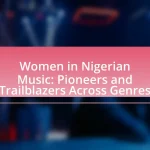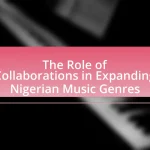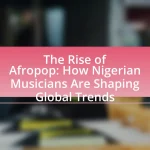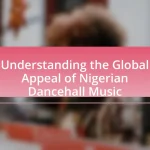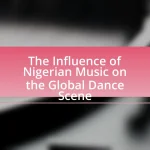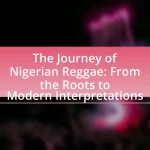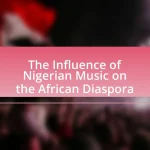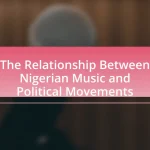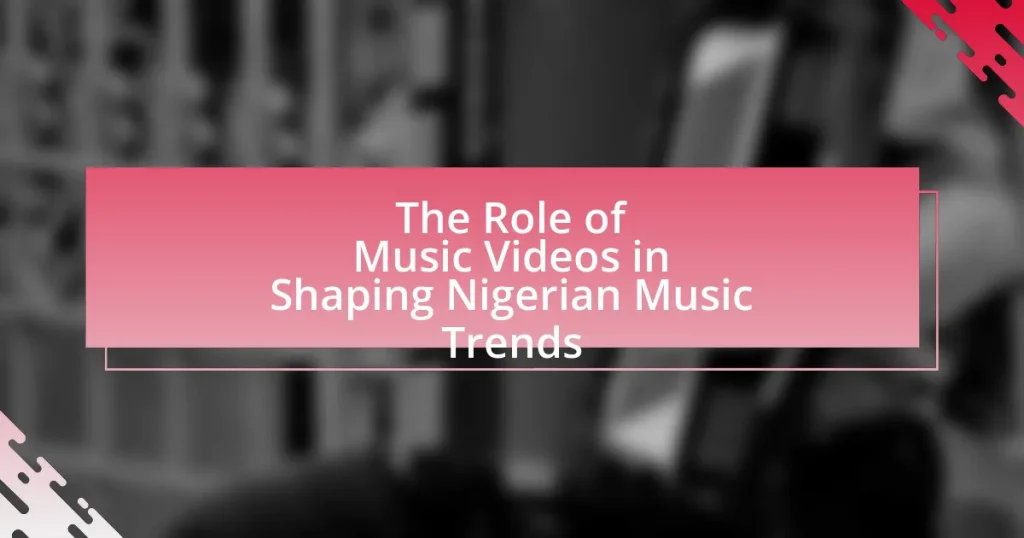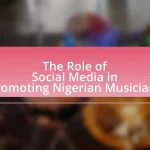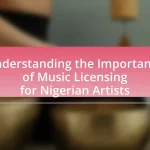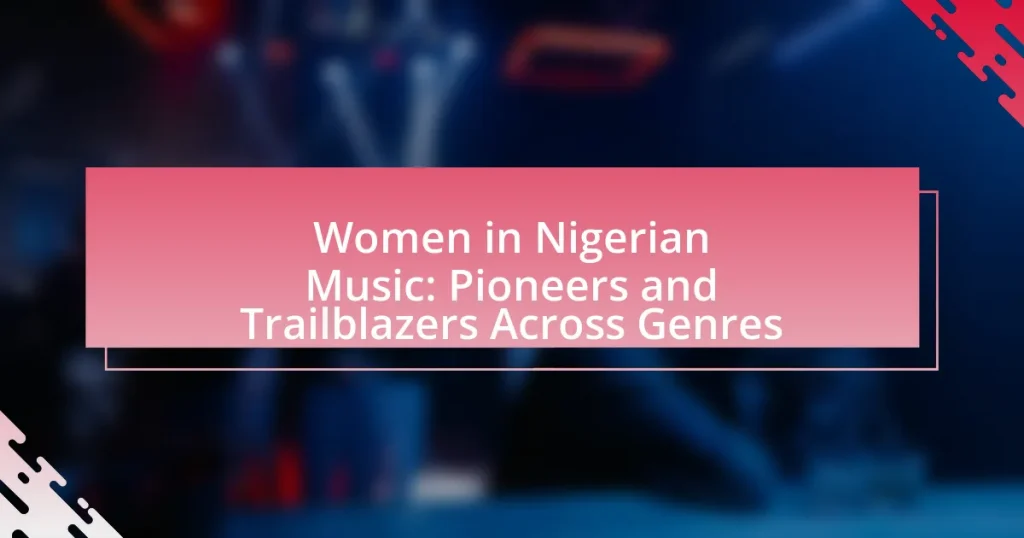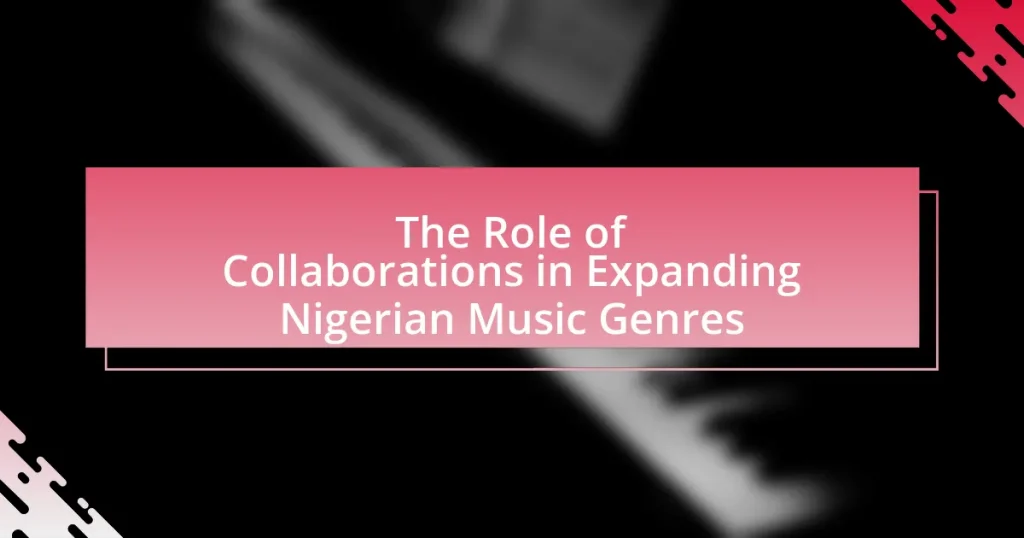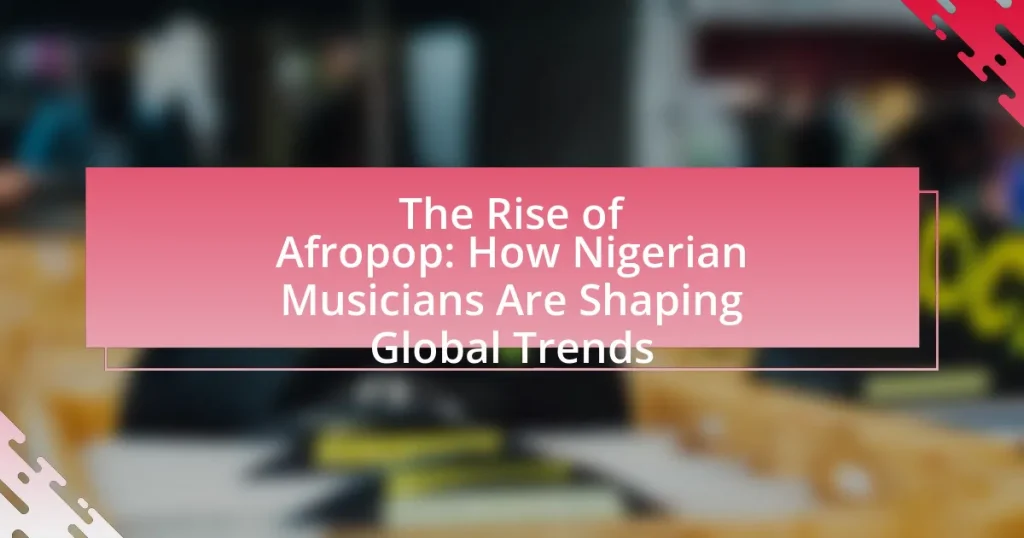The article examines the significant role of music videos in shaping Nigerian music trends, highlighting their impact on cultural representation, storytelling, and artist visibility. It discusses how vibrant visuals and engaging narratives in music videos enhance the appeal of genres like Afrobeats, while platforms such as YouTube facilitate widespread distribution and audience engagement. Additionally, the article explores the influence of music videos on the branding of Nigerian artists, the reflection of cultural trends, and the addressing of social issues within the Nigerian context. It also considers the future of music videos in Nigeria, emphasizing technological advancements and the importance of effective audience engagement strategies.
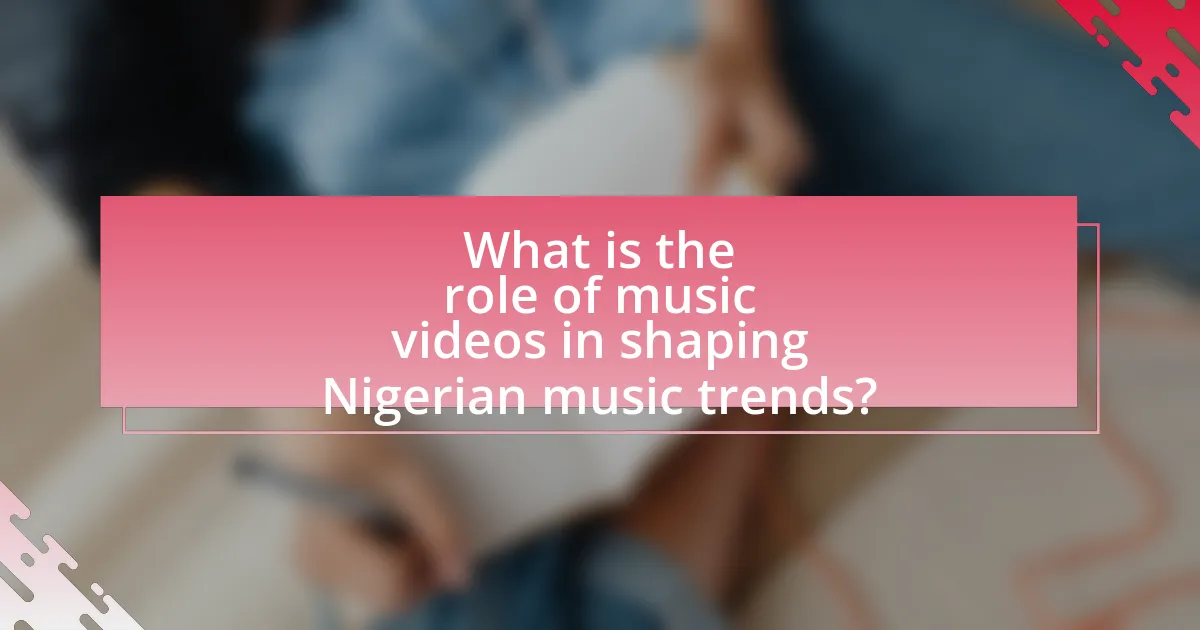
What is the role of music videos in shaping Nigerian music trends?
Music videos play a crucial role in shaping Nigerian music trends by visually representing the culture, style, and narratives of the music. They serve as a platform for artists to showcase their creativity and connect with audiences, influencing popular tastes and trends. For instance, the rise of Afrobeats has been significantly propelled by visually engaging music videos that highlight vibrant dance styles and fashion, making the genre more appealing both locally and internationally. Additionally, platforms like YouTube have become essential for music distribution, with statistics showing that Nigerian music videos often garner millions of views, further solidifying their impact on music trends.
How have music videos influenced the popularity of Nigerian artists?
Music videos have significantly influenced the popularity of Nigerian artists by providing a visual platform that enhances their music’s reach and appeal. The vibrant imagery, storytelling, and cultural representation in these videos resonate with both local and international audiences, thereby increasing the artists’ visibility. For instance, the rise of platforms like YouTube has allowed Nigerian music videos to garner millions of views, with artists like Wizkid and Burna Boy achieving global recognition through their visually captivating content. Additionally, the incorporation of local dance styles and fashion in these videos promotes Nigerian culture, further attracting diverse audiences and contributing to the artists’ popularity.
What specific elements in music videos attract audiences to Nigerian music?
Vibrant visuals, cultural representation, and engaging storytelling are specific elements in music videos that attract audiences to Nigerian music. The vibrant visuals often include colorful costumes, dynamic dance sequences, and scenic backdrops that reflect Nigeria’s rich cultural heritage. Cultural representation is crucial, as music videos frequently showcase traditional elements, languages, and local customs, fostering a sense of identity and connection among viewers. Engaging storytelling in these videos captivates audiences by weaving narratives that resonate with everyday experiences, emotions, and social issues. These elements collectively enhance the appeal of Nigerian music, making it relatable and enjoyable for both local and international audiences.
How do visuals in music videos enhance the storytelling of Nigerian songs?
Visuals in music videos enhance the storytelling of Nigerian songs by providing a visual narrative that complements and amplifies the lyrical content. These visuals often depict cultural elements, social issues, and personal experiences that resonate with the audience, creating a deeper emotional connection. For instance, music videos like “Fall” by Davido showcase vibrant scenes of Nigerian life, which not only illustrate the song’s themes of love and longing but also highlight the country’s rich culture and lifestyle. This integration of visuals and music allows for a more immersive storytelling experience, making the message more relatable and impactful for viewers.
Why are music videos essential for the promotion of Nigerian music?
Music videos are essential for the promotion of Nigerian music because they visually enhance the storytelling and cultural expression inherent in the music. By combining audio and visual elements, music videos create a more engaging experience that resonates with audiences, thereby increasing the reach and impact of the music. For instance, Nigerian artists like Burna Boy and Wizkid have utilized visually captivating music videos to showcase their cultural heritage and attract international attention, leading to significant streaming numbers and global collaborations. This visual representation not only amplifies the artist’s brand but also contributes to the global recognition of Nigerian music as a vibrant and influential genre.
What platforms are most effective for distributing Nigerian music videos?
YouTube is the most effective platform for distributing Nigerian music videos, as it boasts the largest audience reach and engagement levels. According to a 2022 report by Statista, YouTube had over 2 billion monthly active users globally, with a significant portion from Nigeria, making it a prime channel for artists to showcase their work. Additionally, platforms like Instagram and TikTok are also effective due to their visual-centric nature and ability to go viral, with TikTok’s algorithm promoting music trends rapidly among younger audiences. These platforms collectively enhance visibility and accessibility for Nigerian music videos, driving trends and audience interaction.
How do music videos contribute to the branding of Nigerian artists?
Music videos significantly enhance the branding of Nigerian artists by visually representing their music and cultural identity. These videos serve as a powerful marketing tool, showcasing the artist’s style, personality, and message, which helps to create a distinct brand image. For instance, artists like Burna Boy and Wizkid have utilized visually captivating music videos to reach global audiences, thereby increasing their recognition and appeal. The incorporation of vibrant visuals, storytelling, and cultural elements in these videos not only engages viewers but also fosters a deeper connection with the artist’s brand. Furthermore, statistics indicate that music videos on platforms like YouTube can garner millions of views, amplifying the artist’s reach and solidifying their presence in both local and international markets.
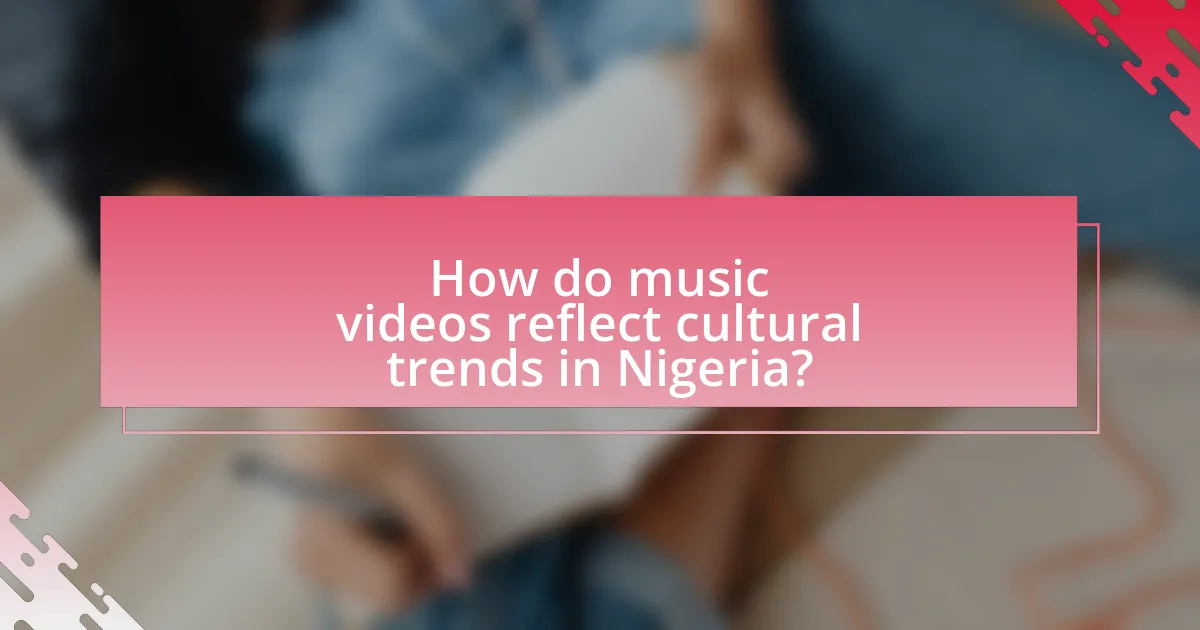
How do music videos reflect cultural trends in Nigeria?
Music videos in Nigeria reflect cultural trends by showcasing contemporary fashion, social issues, and traditional values. They serve as a visual representation of the evolving identity of Nigerian youth, often incorporating local languages, dance styles, and cultural symbols that resonate with the audience. For instance, the prominence of Afrobeat music videos highlights the fusion of traditional African rhythms with modern influences, illustrating a cultural blend that appeals to both local and international viewers. Additionally, music videos often address societal themes such as love, politics, and economic challenges, providing commentary on the realities faced by Nigerians. This connection between music videos and cultural trends is evident in the popularity of artists like Burna Boy and Wizkid, whose visuals often reflect the aspirations and struggles of their generation, thereby reinforcing the cultural narrative within the Nigerian context.
What themes are commonly portrayed in Nigerian music videos?
Common themes portrayed in Nigerian music videos include love, celebration, cultural heritage, social issues, and lifestyle. Love is often depicted through romantic narratives and visual storytelling, showcasing relationships and emotions. Celebration is frequently represented in vibrant party scenes, emphasizing joy and communal gatherings. Cultural heritage is highlighted through traditional attire, dance, and music, reflecting Nigeria’s diverse ethnic backgrounds. Social issues such as poverty, corruption, and inequality are addressed, often aiming to raise awareness and provoke thought. Lifestyle themes showcase luxury, fashion, and success, portraying aspirational living and the rewards of hard work. These themes collectively contribute to the narrative and visual identity of Nigerian music, influencing trends and audience engagement.
How do cultural elements in music videos resonate with Nigerian audiences?
Cultural elements in music videos resonate with Nigerian audiences by reflecting their diverse traditions, languages, and social issues. These videos often incorporate local attire, dance styles, and proverbs, which enhance relatability and foster a sense of identity among viewers. For instance, the use of indigenous languages in lyrics and dialogue connects with audiences on a personal level, as seen in the works of artists like Burna Boy and Wizkid, who frequently blend English with Yoruba and Pidgin. Additionally, music videos that showcase traditional ceremonies or urban life highlight the contrast between modernity and heritage, appealing to a wide demographic. This cultural representation not only entertains but also reinforces social narratives, making music videos a powerful medium for cultural expression in Nigeria.
In what ways do music videos address social issues in Nigeria?
Music videos in Nigeria address social issues by highlighting themes such as corruption, poverty, and gender inequality. For instance, artists like Fela Kuti and Burna Boy use their visuals to critique government corruption and social injustices, effectively raising awareness among viewers. The music video for Burna Boy’s “Another One” explicitly addresses police brutality, reflecting the #EndSARS movement that gained significant traction in Nigeria. Additionally, music videos often depict the struggles of everyday life, showcasing the realities of poverty and the aspirations of the youth, thereby fostering a sense of community and solidarity. This engagement with social issues not only entertains but also educates and mobilizes audiences towards social change.
How do collaborations in music videos shape trends in the Nigerian music industry?
Collaborations in music videos significantly shape trends in the Nigerian music industry by merging diverse musical styles and expanding audience reach. These partnerships often feature artists from different genres, which fosters innovation and encourages cross-genre experimentation, leading to the emergence of new sounds that resonate with a broader demographic. For instance, the collaboration between Wizkid and Drake on “One Dance” not only elevated Wizkid’s international profile but also influenced the popularity of Afrobeats globally, showcasing how such collaborations can set new trends. Additionally, high-profile collaborations often result in increased viewership and streaming numbers, as fans of both artists converge, further solidifying the trend’s impact on the industry.
What impact do international collaborations have on Nigerian music videos?
International collaborations significantly enhance the production quality and global reach of Nigerian music videos. These partnerships often involve renowned international artists and producers, which elevates the visual and auditory standards of the videos, making them more appealing to a broader audience. For instance, collaborations with artists like Drake and Beyoncé have not only introduced Nigerian music to their extensive fan bases but have also led to increased investment in local music production. This trend is supported by the rise of platforms like YouTube, where Nigerian music videos featuring international collaborations have garnered millions of views, showcasing their impact on the global music scene.
How do local collaborations influence the style and content of music videos?
Local collaborations significantly influence the style and content of music videos by integrating diverse cultural elements and artistic expressions. These collaborations often bring together artists from different genres and backgrounds, resulting in a fusion of styles that reflects the local culture and resonates with the audience. For instance, in Nigeria, collaborations between Afrobeat artists and traditional musicians have led to music videos that showcase vibrant local fashion, dance, and storytelling, enhancing the visual narrative. This blending of influences not only enriches the content but also broadens the appeal of the music, as seen in the success of artists like Burna Boy and Wizkid, who frequently collaborate with local talents to create visually compelling and culturally relevant music videos.
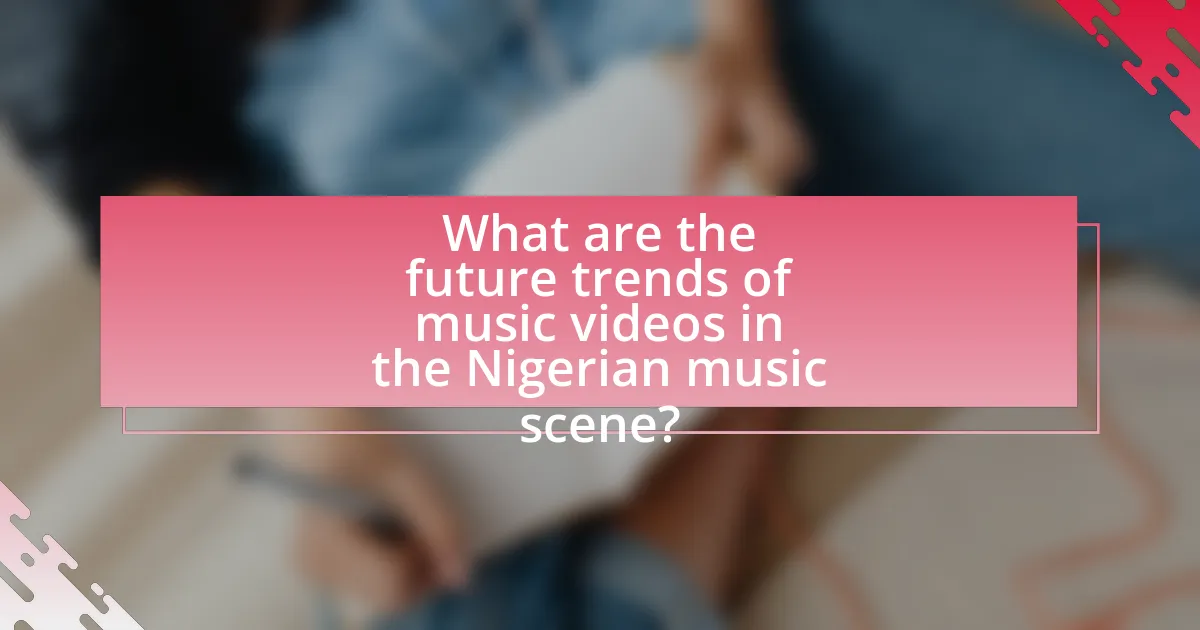
What are the future trends of music videos in the Nigerian music scene?
The future trends of music videos in the Nigerian music scene will increasingly focus on high production quality, storytelling, and digital integration. As the Nigerian music industry continues to grow, artists are investing more in visually appealing content that enhances their musical narratives. This trend is supported by the rise of platforms like YouTube and TikTok, which prioritize engaging visuals and creative storytelling, leading to a demand for innovative concepts in music videos. Additionally, collaborations with international artists and filmmakers are expected to become more common, further elevating the standard of music videos in Nigeria. The increasing use of augmented reality (AR) and virtual reality (VR) technologies in music videos will also shape the future, providing immersive experiences for viewers.
How is technology changing the production of music videos in Nigeria?
Technology is significantly transforming the production of music videos in Nigeria by enhancing accessibility, improving quality, and enabling innovative storytelling techniques. The proliferation of affordable high-definition cameras and editing software has democratized video production, allowing independent artists to create professional-quality content without the need for large budgets. Additionally, advancements in digital platforms facilitate wider distribution, enabling artists to reach global audiences through social media and streaming services. For instance, the rise of platforms like YouTube has led to a surge in music video views, with Nigerian artists gaining millions of views and international recognition. This technological shift not only influences the aesthetic and narrative styles of music videos but also shapes the overall music trends in Nigeria, reflecting a blend of local culture and global influences.
What role do social media platforms play in the evolution of music videos?
Social media platforms significantly influence the evolution of music videos by providing artists with direct access to audiences and enabling viral distribution. These platforms, such as YouTube, Instagram, and TikTok, allow musicians to share their videos instantly, reaching millions without traditional media gatekeepers. For instance, TikTok’s short-form video format has led to the creation of viral music trends, where snippets of songs become popular, driving viewers to seek out full music videos. This shift has transformed how music videos are produced, often prioritizing engaging visuals that cater to quick consumption. Additionally, analytics from these platforms help artists understand audience preferences, allowing for more targeted content creation. The integration of social media in music video promotion has thus reshaped the landscape, making it more interactive and audience-driven.
How are emerging artists utilizing music videos to gain visibility?
Emerging artists are utilizing music videos to gain visibility by leveraging platforms like YouTube and social media to showcase their work and connect with audiences. These platforms allow artists to reach a global audience, as evidenced by the fact that YouTube is the second most visited website worldwide, with over 2 billion logged-in monthly users. Additionally, music videos serve as a visual representation of an artist’s brand, enhancing their storytelling and emotional connection with viewers. This strategy is particularly effective in Nigeria, where music videos are integral to the promotion of new music, contributing to the rise of genres like Afrobeats on the international stage.
What best practices should artists follow when creating music videos?
Artists should prioritize storytelling and visual aesthetics when creating music videos. A compelling narrative enhances viewer engagement and helps convey the song’s message effectively. Additionally, high production quality, including clear visuals and sound, is crucial as it reflects professionalism and can attract a wider audience. Collaborating with experienced directors and cinematographers can elevate the overall quality of the video. Furthermore, incorporating culturally relevant elements can resonate with the target audience, particularly in the context of Nigerian music trends, where cultural representation is significant. Research indicates that music videos that effectively combine these elements tend to achieve higher viewer retention and sharing rates, thereby amplifying the artist’s reach and impact.
How can artists effectively engage their audience through music videos?
Artists can effectively engage their audience through music videos by creating visually compelling narratives that resonate with the themes of their songs. This approach allows artists to enhance emotional connections, as studies show that visuals can significantly impact audience retention and engagement. For instance, a report by Nielsen indicates that music videos can increase song streams by up to 200%, demonstrating the effectiveness of visual storytelling in capturing audience interest. Additionally, incorporating culturally relevant elements and relatable characters in music videos can foster a deeper connection with viewers, particularly in the context of Nigerian music trends, where local culture and storytelling play a crucial role in audience engagement.
What common pitfalls should be avoided in music video production?
Common pitfalls to avoid in music video production include inadequate planning, poor budgeting, and lack of a clear vision. Inadequate planning can lead to disorganization on set, resulting in wasted time and resources. Poor budgeting often results in overspending or compromising on quality, which can negatively impact the final product. A lack of a clear vision can cause confusion among the crew and artists, leading to a disjointed narrative or aesthetic. These pitfalls can ultimately diminish the effectiveness of the music video in conveying the intended message and engaging the audience.
